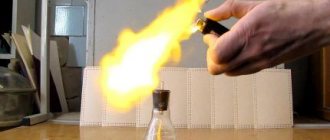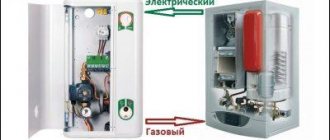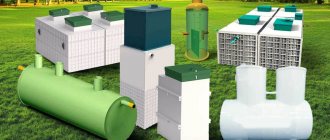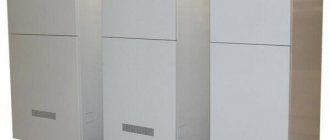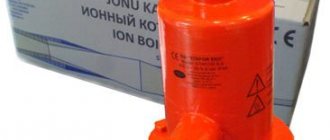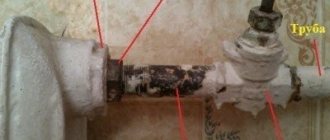Home » Classification of gas boilers » Double-circuit gas boilers » Boiler for a double-circuit gas boiler - built-in, indirect or electric
As you know, the volume of a flow-through heat exchanger for the production of hot water is not always enough. If hot water costs are high, a double-circuit gas boiler with a boiler is installed. It can be indirectly heated or built-in.
…
- 1 Advantages, disadvantages and features of double-circuit units with a built-in boiler 1.1 Connecting double-circuit gas boilers with a built-in boiler
- 1.2 Manufacturers
- 2.1 Connecting a gas unit and an indirect heating boiler
What is a double-circuit gas boiler and what is the difference from a single-circuit one?
A double-circuit boiler differs from a single-circuit boiler in the presence of an additional heat exchanger for preparing hot water (it is sometimes called a DHW heat exchanger).
In addition to the main task - heating the coolant for the heating circuit, the procedure for heating and supplying hot water to consumer appliances is performed . This feature makes the boiler more efficient and in demand.
It is noteworthy that no significant changes are made to the design; an additional flow-type heat exchanger is simply installed in the gap in the straight line between the primary heat exchanger and the three-way valve.
The simplicity and small size of the additions make it possible to use the same housings for both types of units, making production more economical. The cost of the boiler increases only by the price of the additional unit.
Photos in the text to illustrate what was said
Storage tank and electric boiler
Installation of an electric boiler in a heating circuit
Boiler Ariston ABS PRO R 150 V
Water heater model Thermex Champion Titaniumheat 150 V
Types of electric boilers for heating systems
Indirect heating boiler
Device
The main components and parts of double-circuit boilers are:
- gas burner and primary heat exchanger combined with it;
- gas equipment - supply unit, valve, other elements;
- secondary heat exchanger;
- three-way valve;
- turbocharger fan;
- circulation pump;
- expansion tank;
- control board and self-diagnosis sensors.
Boilers created using traditional “open” technology do not have a turbocharging fan, since their smoke removal occurs according to the principle of natural draft, and the air comes directly from the surrounding atmosphere.
Do-it-yourself electric boiler for the heating system
The price of industrial modifications of heating water heaters is very high - from 12,000 to 70,000 rubles. and higher. Therefore, their alternative can be a heater made in-house. For this case, it is allowed to use an arbitrary steel tank of increased strength, with parameters corresponding to the design ones.
To wire the heating circuits of a homemade water heater, you will need the following parts:
- Tank. It would be preferable to place an order from a specialized organization for a device made of non-corrosive steel or assemble it yourself. It is necessary to place holes on the body in order to solder the inlet/outlet pipes.
- Coil heating element, the best choice is copper. This metal has the best heat transfer coefficient and temperature elasticity.
- Fastening elements for piping heating and hot water systems.
- Automatic safety with primary sensors and protective devices in the form of an air vent and an expansion tank. The kit is purchased in a retail chain according to the parameters of the working tank.
- Thermal protection of the boiler from loss of thermal energy. To do this, a glass wool/basalt heat insulator of at least 5 cm is placed in the layer between the tank and the protective casing.
Operating principle
The operation of a double-circuit boiler consists of two streams:
- The coolant enters the primary heat exchanger and receives the maximum possible temperature. It is then passed through a secondary heat exchanger, where it transfers some of the resulting energy to prepare hot water. After this, it passes into a three-way valve, receives the desired temperature by mixing some of the return flow, and is discharged into the heating circuit for a new circulation circle;
- cold water enters the boiler and is passed through a secondary heat exchanger. After that, it goes to the consumption devices. When the tap opens, water begins to pass through the plate device and heat up in flow mode. The more water is drawn, the lower the water temperature - at high flow rates it does not have time to heat up properly.
The coolant is prepared in the flame of a gas burner. For its operation, air is required, which is supplied by the turbocharger fan. Excess pressure arises, pushing the smoke out through a special coaxial chimney.
The operation of all system components is constantly monitored by self-diagnosis sensors.
They immediately signal the occurrence of failures or malfunctions, the control board places an alert on the display, and in some dangerous situations immediately turns off and locks the boiler.
NOTE!
Non-volatile models are equipped only with mechanical parts. They are much simpler and do not have fans, centrifugal pumps or control units. The functioning of the system occurs on the basis of natural processes of traction and lifting of warm layers of liquid upward.
Criterias of choice
How to choose a boiler for heating your home? To do this, you need to consider the following factors:
- Design features. The best option for a heating boiler is to place the inlet on top of the tank, and the outlet on the bottom, and their diameter should be more than 2 inches. When the inlet and outlet are located on one side, a pump is installed.
- Device power. When using a boiler to heat water, it is necessary to select a device with maximum power - 3.5-5 kW, which will make it possible to heat a room of up to 50 m². A specialized heating boiler must have a power of at least 7-8 kW.
- Volume of the tank. For heating, only a device with a large tank is suitable, which will make it possible to operate the heating element in a gentle mode - the maximum power is set during initial heating (1-1.5 hours) to form a reserve of coolant, and then decreases. In domestic boilers, the tank volume should be about 70-120 liters, in specialized ones - more than 200 liters.
- Materials used. During operation, the tank material is subject to significant corrosion.
When choosing a boiler, you should pay attention to the presence of a protective coating and the material used:
- Porcelain glass or enamel coating provides good protection against corrosion only if it is intact. Mechanical stress and sudden temperature changes cause cracks and other damage, which creates an active corrosion zone.
- The tank body made of stainless steel or titanium is strong and durable, not subject to corrosion. The main disadvantage is that such boilers have a higher cost.
Kinds
There are different design options for double-circuit boilers. They can be conditionally united according to specific characteristics.
By installation method:
- wall- mounted Gas boilers that are mounted in a hinged manner on strong, preferably load-bearing walls. The installation method implies the absence of massive and heavy parts. Because of this, the power of wall-mounted boilers does not exceed 35-40 kW;
- floor . They are installed directly on the floor (or on a stand). There are no restrictions on weight and dimensions, so the power of floor-standing boilers can be much greater - up to 100 kW and higher. Also, floor-standing units can be connected in a cascade (usually up to 4 pieces), which allows you to create a powerful heating unit.
By heat exchanger type:
- separate . The design of such boilers has two units - a primary (main) unit in which the coolant is heated, and a secondary unit (usually plate-type, for hot water supply);
- bithermic . This design resembles a coaxial pipe in which coolant flows through the outer cavity, and water for hot water flows through the inner cavity. This design significantly changed the specifics of water heating. The temperature has stabilized, there are no noticeable differences in the DHW supply . However, such a heat exchanger is susceptible to the formation of lime deposits. Flushing does not give noticeable results, and replacing a bithermic heat exchanger is too complicated and expensive.
The material for the heat exchanger can be:
- stainless steel . Used for units of budget units;
- copper . Used in expensive boilers from the most famous manufacturers. They have high performance capabilities and are lightweight, which is important in wall structures;
- ductile cast iron . Heat exchangers of this type are found in floor-standing boilers, where massive parts can be used. The qualities of cast iron make it possible to obtain a high heating effect and equalize temperature changes under harsh operating conditions.
By type of combustion chamber:
- open (atmospheric) . The burner operates on air that comes directly from the room. Smoke removal occurs naturally, using a stove-type draft. To do this, the boiler must be connected to the central chimney. This method is considered outdated and unstable, since it depends on external causes - gusts of wind, drafts, and other factors;
- closed (turbocharged) . The chamber does not communicate with the outside atmosphere, so air is supplied into it using a fan. In this case, excess pressure arises in the chamber, displacing smoke and other combustion gases out. In such designs, a coaxial type chimney is used, the outer pipe of which serves to supply air, and the inner pipe exhausts smoke.
By heat transfer method:
- convection _ Conventional heating of a coil with coolant in a burner flame;
- condensation _ A two-stage heating of the coolant is carried out, preliminary (with heat obtained from condensation of wet smoke) and main (in the usual way). It is necessary to take into account that full operation of such boilers is possible only in low-temperature heating systems - with heated floors, or in regions with high winter temperatures . The critical temperature difference between inside and outside the room at which the process stops is 20°. In Russia this is impossible even in the southern regions.
IMPORTANT!
When choosing a condensing boiler, you should know exactly the principle of its operation and be confident in the possibility of using it in the existing conditions. Otherwise, the money will be wasted.
Connection to the house electrical network
The power of the vast majority of water heaters does not exceed 3.5 kW. If the consumption of your household appliance is within the specified limits, feel free to connect the boiler through a standard socket equipped with a grounding contact (required!). The work is simple: run a three-core cable from the distribution box using a corrugated cable or plastic box, and place a socket next to the heater.
Exposed wiring and outlet knobs are not popular with all homeowners. To make the electrical connection to the water heater more efficient, follow our instructions:
- Lay the cable in a hidden way - in the grooves of the walls or under plasterboard sheathing, connecting it to the nearest electrical outlet box or directly to the electrical panel.
- Install a two-pole 20 A circuit breaker in a convenient place, placing it in a decorative plastic box.
- Using the clamps, connect the cable to the machine.
- After unscrewing the fastening screws, remove the cover from the bottom of the boiler. There is a connector hidden under it where you need to connect the wires. Do not forget about the grounding contact - it must be connected to the appropriate bus.
Plug in the boiler filled with water and check its functionality. Since on budget versions of the devices the heating temperature is regulated directly on the heating element, do not rush to put on the lid. Wait until the water reaches a comfortable temperature (look at the indicator) and turn the adjusting lever at the end of the heating element so that the heating element turns off.
Do you need a boiler?
A double-circuit boiler is capable of independently preparing hot water and does not require additional devices . This is a common view, and it is generally correct.
However, many users are not satisfied with the DHW supply mode in their homes. This usually happens due to a large number of water taps, numerous families, etc. For these cases, there is a way to connect an external drive as a buffer capacity.
Hot water fills the container and is replenished as needed.
The boiler's DHW supply can be adjusted so that the flow rate is minimal . This will ensure high temperatures and stabilize the supply of hot water to consumers.
Specifications
When choosing a model of the system in question, the technical characteristics must correspond to the level of expected comfort and the amount of heat and hot water used. Since they will vary greatly depending on the area of the room and the activity of using the system. Because some owners visit private houses only for a short period of time, while others live in them permanently.
The number of people living and the presence of pets also greatly influences. Because, in any case, the more people live, the more hot water is used. Therefore, when choosing a model, it is necessary to take into account all the characteristics of the heated object in order to choose the best option.
Most popular manufacturers
European companies are considered the most reliable and popular manufacturers.
These include:
- Vaillant;
- Viessmann;
- Navien;
- BAXI;
- Protherm;
- Buderus;
- Bosch, etc.
The list can be continued for a long time, but there is little point in listing the names of companies. on the market, offering their developments and models .
This allows you to choose the most suitable boiler with the required parameters.
Advantages
Modern models of gas boilers with one circuit for heating the heating fluid could be called primitive water heating devices if they were not equipped with high-precision control and monitoring equipment to ensure the reliability and safety of all operating cycles. To solve the problems of regulation and safety of boilers, an automatic boiler protection system with gas flow and pressure regulators, fittings that regulate the flow, temperature and pressure of heated water, all kinds of sensors, instruments and safety devices is aimed. This is the main advantage of gas boilers.
Other important benefits:
- simplicity of design and installation of the boiler, which includes a combustion chamber with a gas burner, a loop heat exchanger in the firebox, a system of manifolds and pipelines, and pumping equipment;
- efficiency achieved by automation and adjustment work for optimal and efficient combustion of fuel, mixing processes and regulation of coolant parameters in accordance with standards;
- the ability to connect boilers to cascade heating systems within cities and large towns, which allows not only to centrally control the system, but also to ensure reliable and high-quality heat supply to consumers in residential areas, neighborhoods, microdistricts, as well as enterprises whose boiler houses are included in the cascade;
- more environmentally friendly emissions of gas combustion products into the atmosphere compared to similar boiler houses using liquid and solid fuels.
How to calculate power?
Calculating boiler power is too complex a task. An unprepared person cannot cope with it . However, there is a simple calculation option that gives an approximate, but quite acceptable result.
Heating 10 m2 of area requires 1 kW of thermal energy. Based on this ratio, you can quickly determine the required boiler power. For example, for a house of 200 sq.m. you need 20 kW of thermal energy.
A unit of either 18 or 24 kW is suitable.
NOTE!
You should not make a large power reserve, since the boiler begins to operate at minimum mode. Frequent starting and stopping of the burner contributes to the rapid failure of components, and scale accumulates in the heat exchanger. The result will be the need for expensive repairs or the purchase of a new boiler.
Advantages and disadvantages
The main advantage of boilers for heating a home is the simplicity of the system and low cost. To install boiler heating, no special equipment is required, and installation can be done independently.
The main disadvantage of boilers is their low power. Conventional household appliances are capable of heating only small houses and cottages, and even in moderate frost outside. In addition, heating elements must operate continuously in the cold season, which leads to their frequent failure. The heaters themselves have a low price, but repairs are quite labor-intensive, which stops the heating system for a long time.
Rating of TOP 5 double-circuit boilers
Let's consider several popular models of double-circuit boilers:
Buderus Logamax U072-12K
When talking about Buderus boilers, it is necessary to keep in mind that today it is a “daughter” of the world-famous Bosh concern. This determines the general attitude of manufacturers towards their products, the level of requirements and quality.
The brand was built for the production of budget gas boilers, since it is unacceptable for Bosh to reduce the price of its products from a reputational point of view.
The Buderus Logamax U072-12K boiler has a power of 12 kW, which allows it to be used for heating rooms up to 120 sq.m.
The unit is equipped with a copper primary and stainless steel secondary heat exchangers. There is multi-stage protection against freezing, overheating and other undesirable situations.
Main characteristics of the boiler:
- coolant temperature (min-max) - 40-82°;
- temperature in the DHW circuit - 40-65°;
- maximum pressure in the heating system - 3 Bar;
- pressure in the DHW circuit - 8 Bar;
- gas consumption - 2.1 m3/hour;
- dimensions - 400x700x299 mm;
- weight - 29 kg.
The design of the boiler allows it to withstand pressure fluctuations in the gas or water supply system.
It is possible to switch to liquefied gas, which requires a replacement set of gas burner nozzles.
Bosch Gaz 6000 W WBN 6000- 12 C
Double-circuit gas boiler from a world-famous industrial giant. 12 kW of power allows you to heat 120 m2 of area, while simultaneously providing it with hot water .
The unit is equipped with a copper heat exchanger and a stainless secondary component. The volume of the expansion tank is 8 liters, which is quite enough for a 12 kW device.
Basic parameters of the boiler:
- coolant temperature (min-max) - 40-82°;
- temperature in the DHW circuit - 35-60°;
- maximum pressure in the heating system - 3 Bar;
- pressure in the DHW circuit - 10 Bar;
- gas consumption - 2.1 m3/hour;
- dimensions - 400x700x299 mm;
- weight - 28 kg.
Provided that a different set of nozzles is installed, it is possible to reconfigure the boiler to operate on liquefied gas. The permissible butane pressure is 25 mbar, so a reduction reducer is required to connect the cylinder.
Lemax PRIME-V32
The Russian company Lemax is based in Taganrog. The PRIME-V32 boiler is a high-quality double-circuit wall-mounted unit. The design demonstrates high performance.
A separate heat exchanger (primary copper, secondary stainless) ensures efficient heat transfer. The power of the unit is 32 kW, allowing you to heat an area of up to 320 sq.m.
Main characteristics:
- coolant temperature (min-max) - 35-85°
- temperature in the DHW circuit - 40-65°;
- maximum pressure in the heating system - 3 Bar;
- pressure in the DHW circuit - 8 Bar;
- gas consumption - 2.0 m3/hour;
- dimensions - 430x770x340 mm;
- weight - 32 kg.
Lemax boilers differ from other domestic heating products in their approach - most boilers are non-volatile and operate on the principle of a gas stove.
The products of engineers from Taganrog demonstrate a European approach and high performance.
Lemax Premium-30B
This is another example of domestic heating units. Premium-30B is a floor-standing double-circuit boiler with a capacity of 30 kW.
It is suitable for rooms up to 300 sq.m. A massive and heavy unit with an atmospheric burner requires a separate room with its own entrance and window opening.
Main characteristics:
- coolant temperature (min-max) - 40-90°
- temperature in the DHW circuit - 40-70°;
- maximum pressure in the heating system - 3 Bar;
- pressure in the DHW circuit - 6 Bar;
- gas consumption - 3.5 m3/hour;
- dimensions - 556x961x470 mm;
- weight - 88 kg.
Floor-standing boilers are less often produced in a double-circuit version than wall-mounted ones. They are easier to connect to an external water heater, so single-circuit designs are more often offered .
Switching to liquefied gas is possible, but you will need to install a new set of nozzles and reconfigure the boiler parameters.
Navien SMART TOK 24K
The Korean company Navien focuses on the mass buyer, producing affordable boilers in the budget price range. At the same time, the quality of the units is high enough to successfully compete with European models.
The SMART TOK 24K boiler is designed to heat 240 sq. m., which confirms the power of 24 kW. It is equipped with steel heat exchangers and a closed burner.
Options:
- coolant temperature (min-max) - 40-80°
- temperature in the DHW circuit - 30-60°;
- maximum pressure in the heating system - 3 Bar;
- pressure in the DHW circuit - 8 Bar;
- gas consumption - 2.79 m3/hour;
- dimensions - 440x695x290 mm;
- weight - 28 kg.
Many people criticize Korean technology for its high noise level and low strength of some parts.
However, the high demand and demand for boilers from the Korean company show a positive attitude from the majority of buyers.
Determining the efficiency of a new water heater
How to start using your new boiler economically and correctly? Experts focus on determining its energy efficiency when purchasing.
General rules
Before purchasing equipment, the user needs:
- compare the energy efficiency of expensive and budget models in the store to establish the return on investment of the equipment;
- clarify that the energy efficiency class includes efficiency, losses per hour during heating and maintaining temperature, circulation. Information is indicated in the manufacturer's booklet;
- take into account the displacement of the container, the operating speed of the heating element, the type of installation to clarify the total costs.
Interesting to know! On European boiler models, energy efficiency has been indicated since 2013, on American ones - since 2009.
Calculation of annual operating costs
For calculations, you will need information about the energy efficiency class, type and cost of the coolant. Further calculations are performed using the formula:
- for gas models, the number of days per year is multiplied by energy efficiency and the cost of a cubic meter of gas;
- for electric boilers, the number of days per year is multiplied by energy efficiency and the cost of kW/hour.
Interesting to know! The DOE test for water heaters takes into account cold (15 degrees) and hot (60 degrees) temperatures and determines the unit's performance for a family of 3 as 240 liters per day.
Heating element power as a saving factor
The greater the power of the heating element, the faster the water will heat up. Keep in mind that in houses with a single-phase wiring diagram, from 7 to 10 kW of power are allocated. A high-performance water heater will lead to increased load on the network, huge energy costs and tripping of circuit breakers.
Electrical connection diagram
The combined version of the tank, equipped with a heating element, must be connected to the house electrical network, taking into account the transition to summer mode, in which the main coil will no longer receive heat from the boiler. We suggest using a universal circuit that includes a pump control module via a thermostat.
The colors of the wires shown in the figure correspond to the generally accepted classification: blue - neutral, brown - phase, yellow-green - ground, and so on
The circuit involves a second safety thermostat, which is activated when the sanitary water overheats. The indicator lamp signals that the heating element is turned on.


